Northrop P-61 Black Widow: The First American Specialized Night Fighter
At the very beginning of World War II, the United States simply did not have night fighters. This was mainly due to the late start of the development of such aircraft and fighter guidance radars. The creation of specialized night airplanes stalled, since there was no experience in their combat use. Unlike the European theater of operations, the air war in the Pacific and in China was conducted mainly during the day and in good weather, at night the Japanese aviation showed no activity. In turn, in Europe, after the failure of the daytime raids of the Luftwaffe on Britain, the Germans switched to night raids.
Despite this, the US military insisted on the need to have armed air forces specialized night fighter-interceptors, predicting a sharp increase in the activity of the Japanese Air Force at night. But on the specific aircraft views of the military diverged. Some advocated the use of British night fighters Bristol Beaufighter and De Havilland Mosquito, which had already been tested in combat, while others were in favor of their own American project, the Northrop P-61 night fighter. In the end, the American command stopped on the Northrop P-61 Black Widow fighter, before its mass production in the US Air Force there were only a limited number of “early-ridden” night fighters - adapted for the nightly action of the “Listing” versions of the P-38M and the specialized version bomber A-20 "Havok". These combat aircraft, with the exception of a small number of “experimental” cases, were used only in the United States for training and training crews.
As a result, the Northrop P-61 Black Widow was the only American combat aircraft produced during the Second World War, which was originally developed exclusively as a specialized night fighter. In addition, the Northrop P-61 became the heaviest and largest fighter that entered service with the USAAF during World War II. This fighter for the first time took part in the fighting in the summer of 1944, in the southern Pacific, and after the end of hostilities remained the standard USAAF night fighter until 1952, when the operation of this aircraft was discontinued.
The P-61 night fighter was developed by a group of engineers led by designer John Nortrop, the aircraft was actively developed since the summer of 1940, while Northrop itself was founded only in August of 1939. Already 10 January 1941, the US military signed a contract with the company to build 10 night fighters, which received the army designation XP-61. The contract for the first prototypes was already 10 March 1941, followed by a contract for the production of 13 YP-61 fighter jets for carrying out field tests and one more machine for static tests.
Already 24 December 1941, even before the first prototype of the new aircraft was manufactured, Northrop signed a contract for the production of the X-NUMX serial P-100 fighter aircraft and their supply with the necessary number of spare parts. 61 January 17, the military ordered another 1942 aircraft, and already 50 February order was increased by 12 aircraft, 410 of which was planned to deliver the Royal British Air Force in the framework of the lend-lease agreement. Subsequently, the order for the RAF was canceled, and the order in the interests of the US Air Force was increased to 50 aircraft.
In the process of creating the first prototype XP-61, due to various changes in its design, the take-off weight of the aircraft was constantly increasing. By the time the fighter was ready, its dry weight was already 10 150 kg, and the takeoff weight reached 13 460 kg. Taxiing tests of the new night fighter began almost immediately after the assembly of the first aircraft. And already on May 26, 1942, the first XP-61 prototype, equipped with two Pratt & Whitney R-2800-25 Double Wasp radial engines, took to the skies for the first time, the car was lifted into the air by Northrop test pilot Vance Brice. The first flight lasted only 15 minutes, while the pilot already noted that the plane was perfectly controlled.
The second XP-61 flight prototype was ready on November 18 of the year 1942. From the very beginning, this aircraft was painted in a brilliant black color, which helped give the night fighter its name - Black Widow, the Black Widow - in honor of the spider widespread in North and South America. It is worth noting that covering the aircraft with black paint was not someone's whim. The Massachusetts Institute of Technology specially created paint, which was supposed to make the night fighter invisible when the plane hit the enemy's searchlights. The best paint for this purpose turned out to be black glossy, which was invisible in 80 as a percentage of the searchlight rays.
The design of the aircraft Northrop P-61 Black Widow
The P-61 Black Widow night fighter was an all-metal cantilever midwing plane, which was built on a two-boom scheme. The power plant of the aircraft included two powerful piston twin-row radial Pratt & Whitney R-2800 engines, the power of which reached 2x2250 hp. The engine nacelles went into the tail booms, the keels were made in one piece with the booms and stabilizers located between the keels. The fighter's unique two-boom design allowed its crew to be accommodated in a large gondola, which was installed on the center section. The landing gear of the aircraft is tricycle, retractable, with a nose pillar.
The crew of the night fighter consisted of three people - the pilot, the gunner and the radar operator. In the front two-seat cockpit were located the workplaces of the pilot and radar operator, who sat behind him and higher, as on modern attack helicopters. Workplace shooter located in the rear fuselage gondola. Depending on the presence or absence of an upper turret with four 12,7-mm machine guns, the shooter could have been activated or, on the contrary, excluded from the crew. Often planes flew, having on board two crew members. At the same time, in some flights, even without the upper turret, the shooter was included in the crew, but as an air observer.
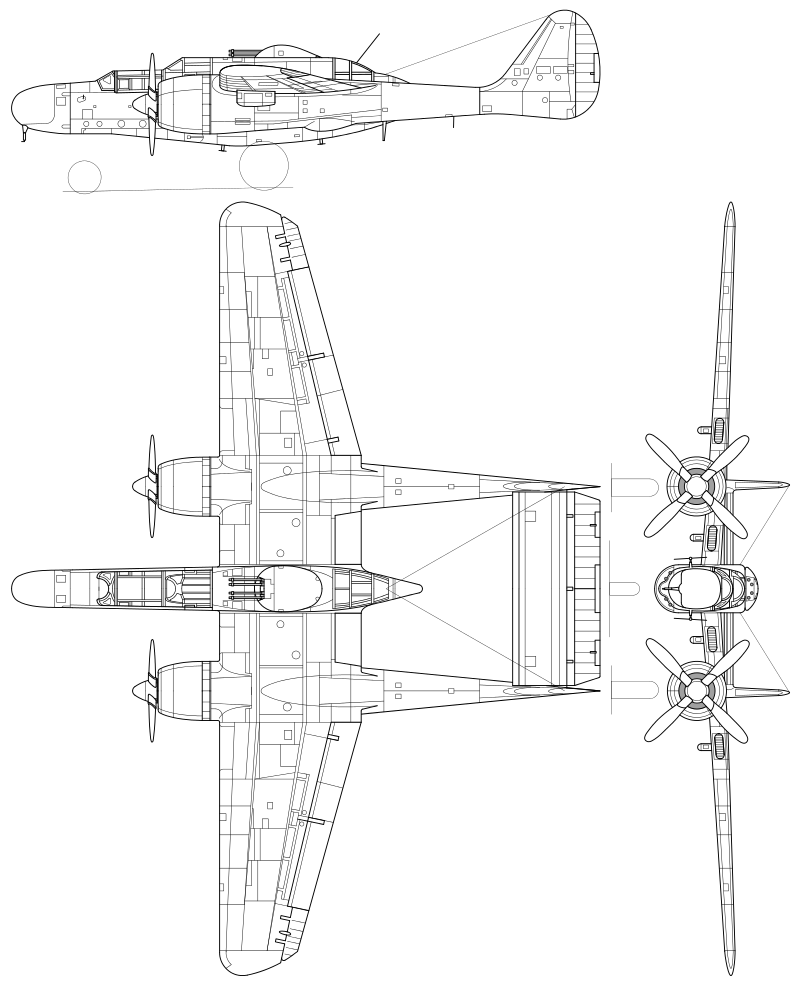
A distinctive feature of the aircraft was that it was originally designed for use as a night fighter (as opposed to numerous modifications of conventional mass-produced vehicles used by the warring parties), equipped with on-board radar and various electronic instruments. The aircraft was applied airborne radar interception system (Airborne Interception - AI). The development of the radar for the P-61 fighter was carried out under the supervision of the National Research and Protection Committee, which created the radar laboratory at the Massachusetts Institute of Technology. The preliminary development of the radar, designated AI-10 (military designation SCR-520), was completed by June 18 1941. It was created on the basis of the British aircraft centimeter range.
The SCR-520A radar had a search radio transmitter located in the nose of the fighter, with a range of up to five miles. Also, this radar could be used as a side beacon, provide navigation assistance and be used for action in conjunction as an “friend-foe” answering machine. The radar operator SCR-520 in the P-61 night fighter “Black Widow” determined the air target and direction to it, and the pilot directed the plane to the target using instruments that were located in the center of its dashboard. Black Widow used airborne radar only to determine the course of interception of the air target and the subsequent pursuit of the enemy aircraft. Having found the target and approached it at a distance sufficient for an attack, the pilot used an ordinary optical sight.
Essentially, the Black Widow was a heavy and rather large aircraft that was extremely complex in terms of design. At the same time, outwardly the plane, to put it mildly, looked strange and seemed very large to the fighter. For example, the area of its wing was 61,53 m 2, for a minute it is more than that of the heavy American all-weather X-NUMX fighter of the F-4 generation. The cockpit of the P-15 Black Widow night fighter was more spacious than that of many medium bombers of that time.
Armament fighter was really impressive. At the bottom of the fuselage gondola was a battery of four aircraft automatic 20-mm guns. In addition to this, on many aircraft there was a rotating upper turret on four large-caliber 12,7-mm machine guns. The aircraft was a real "flying anti-aircraft battery", which was quite effective. From the salvo of this fighter could not resist any of the enemy aircraft. However, as the Black Widow exploited, the upper fuselage turret began to be abandoned, since the air targets were guaranteed to be hit by a volley of four guns. In addition, the turret itself weighed 745 kg, so its dismantling provided the aircraft with a significant gain in speed and maneuverability. In addition, when turning the turret, such an effect as a fighter's tail was often occurring. Sometimes because of this effect, the turret was simply fixed in the front position, it was impossible to rotate it.
The features of the aircraft could be attributed, and unusually powerful flaps. John Northrop, better than many aircraft designers, understood how important the lift coefficient for an aircraft was, so its night fighter had flaps almost throughout its wing span. Regular ailerons were small, but four sections of differential spoilers on each of the consoles took part in the roll control. This design solution provided the Black Widow with excellent maneuverability, especially taking into account the size and weight of the fighter. Of course, in daytime combat, neither this nor the powerful weapons, could have saved the plane from the German FW-190 fighter, but in the night sky P-61 was superior in maneuverability to any twin-engine aircraft of its time.
The plane was built in three large series. The first was the P-61A version, a total of 215 fighters released. The first 45 machines received engines R-2800-10, the subsequent - R-2800-65. The first 38 aircraft were released with the top machine-gun turret, the rest without. At the same time, the turret was installed on some P-61A aircraft. The second series - fighters P-61B, released 450 aircraft. This model was notable for minor improvements in the design, most of them had a top machine gun turret, as well as four underwing pylons for the suspension of air-to-surface weapons. The difference was also more powerful and sophisticated airborne radar SCR-720C. The third series - fighters P-61C, released 41 aircraft at the very end of the war. Originally it was planned to build a series of 476 aircraft, but these plans were canceled. The aircraft differed in the installation of more powerful R-2800-73 engines with CH-5 turbo-compressors, which developed the maximum power of the 2800 hp. each. With these motors, the maximum speed of the fighter increased to 692 km / h.
Combat use of "Black Widow"
In total, 14 squadrons of night fighters armed with P-61 Black Widow aircraft took part in battles in all theaters of war. These squadrons were part of the 5 th, 7 th, 9 th, 13 th and 14 th air armies. The first squadron, which was reequipped with new aircraft, was the 6-th night fighter squadron (6 NFS), which was part of the 7-th Air Army. She received the new 1 aircraft in May 1944, at that time she was based in John Rogers Field in the Hawaiian Islands. Since September 1944, the aircraft of this squadron took part in the fighting over Saipan and Iwo Jima.
6 NFS pilots won the first night victory on 30 June 1944 of the year. On this day, during a night flight, the squadron aircraft found a group aerial target, which was then identified as a Japanese Mitsubishi G4M Betty bomber, accompanied by a Mitsubishi A6M Zero fighter. The crew of the American aircraft from the first approach achieved hits in the left engine of the bomber, which fell into the sea and exploded near Saipan. In this case, the escort fighter Mitsubishi A6M Zero failed to detect an American plane. Total crews 6 th night fighter squadron won until the end of the Second World War 15 night victories. One of the main missions of the Black Widows in this theater was to protect the bases of the B-29 strategic bombers on Saipan against enemy night raids. They also protected damaged B-29 bombers returning from combat missions to Japan from attacks.
The first victory at the European theater of war fighters P-61 Black Widow won in the night from 15 on July 16 1944 of the year. The crew of the 422 NFS shot down a German V-1 projectile that flew towards the English Channel. The V-1 was able to shoot down 280 meters from 20-mm guns from a distance of about a meter. Hit in the power plant of the projectile led to the fact that he first entered a steep dive, and then exploded over the English Channel. Later on, night fighters of this type were widely used against German projectiles. At the same time, since the V-1 was a bit faster than American fighters, they sometimes had to go into a small dive before attacking.
In total, during the 1944-1945 years, in fact, the combat use of fighters fit in the calendar year, the crews of the "Widows" shot down 127 enemy planes and 18 V-1 projectiles. Unlike other American fighter type P-51 Mustang or P-47 Thunderbolt, P-61 Black Widow could not boast an impressive number of air victories. But this was his explanation, by the time the aircraft began operating, the Allies already had overwhelming air superiority on all fronts, and the number of enemy aircraft participating in night flights was very limited, especially over the Pacific Ocean.
At the same time, the activity of the Luftwaffe in Europe in the dark remained almost until the end of World War II. Therefore, in this theater, the P-61 Black Widow aircraft were used in the role for which they were designed - as night fighters. But in the Pacific, the situation has evolved differently. The Japanese practically did not fly at night. Therefore, the headquarters of the 5 and 13 air armies decided to retarget their night fighters to night attacks of enemy ground targets and direct fire support from the US Army and Marine Corps. The powerful cannon armament of the P-61 Black Widow fighter jets, which was concentrated in the center of mass of the aircraft, made it possible with high accuracy and very effectively to hit ground targets. Additionally, under the wings of the aircraft could be installed pylons for the suspension of bombs, unguided rockets and tanks with napalm, which only complemented the already monstrous power of the onboard volley of this “flying battery”. So in the spring and summer of 1945, the Black Widow night fighters were actively used in the Philippines to support ground forces, mainly attacking targets during the daytime hours.
Flight specifications: Northrop P-61 Black Widow (P-61B):
Overall dimensions: length - 15,11 m, height - 4,47 m, wing span - 20,12 m, wing area - 61,53 m2.
Empty weight - 10 637 kg.
Maximum take-off weight - 16 420 kg.
The power plant consists of two Pratt & Whitney R-2800-65W "Double Wasp" radial engines with a capacity of 2x2250 hp.
The maximum flight speed is 589 km / h (at a height of 6095 m).
Cruising flight speed - 428 km / h.
Rate of climb - 12,9 m / s.
Combat radius - 982 km.
Ferry range (with PTB) - 3060 km.
Practical ceiling - 10 600 m.
Armament: 4 × 20 mm cannon Hispano AN / M2 (200 projectiles per barrel) and 4x12,7 mm M2 Browning machine gun (560 ammunition per barrel).
Crew - 3 man (pilot, gunner, radar operator).
Information sources:
http://www.airwar.ru
http://www.airpages.ru/us/p61bp.shtml
http://pro-samolet.ru/samolet-usa/63-istrebiteli/411-usa-istrebitel-northrop-p-61-black-widow
Open source materials
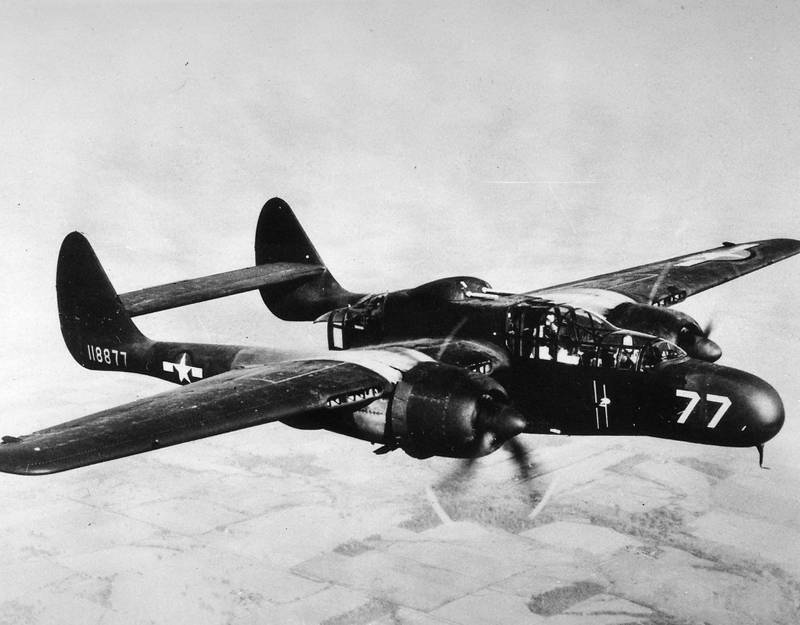
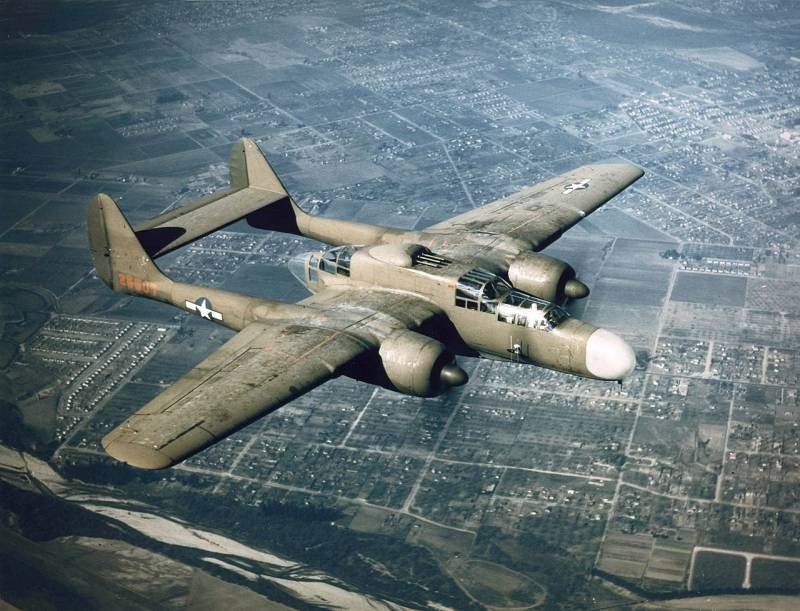
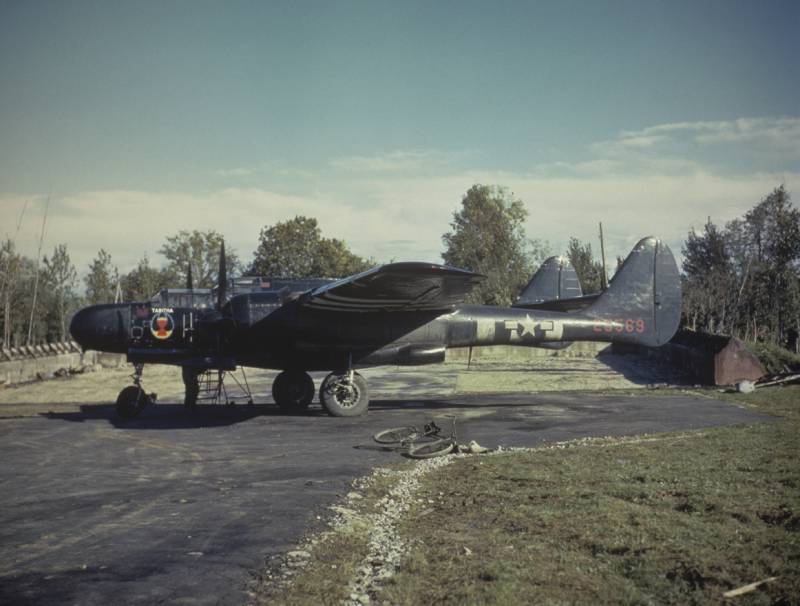
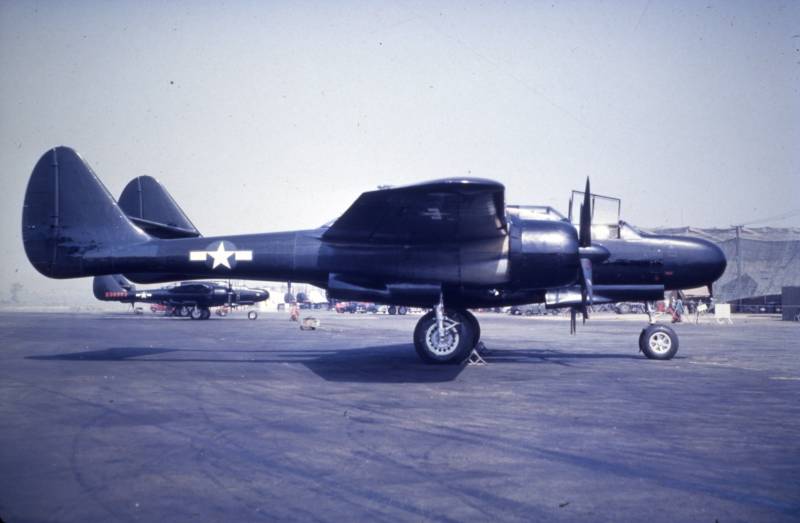
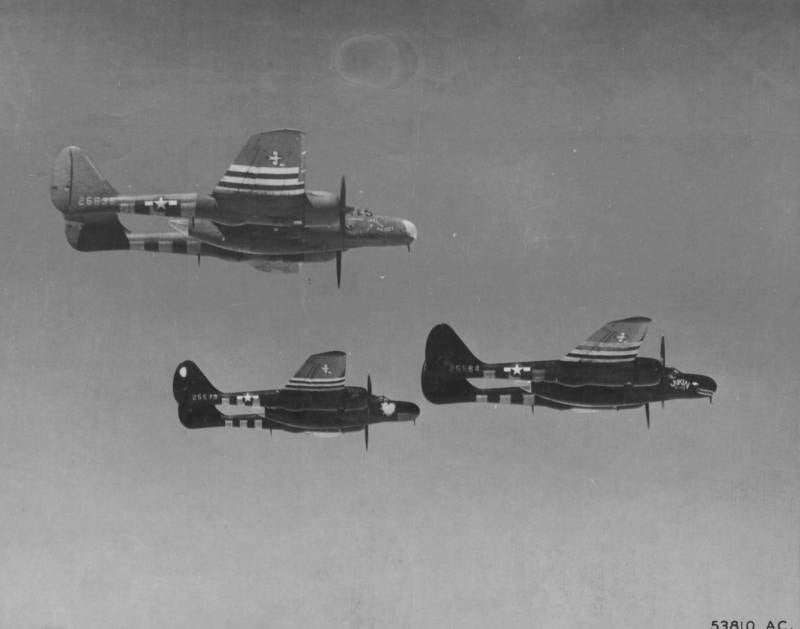
Information